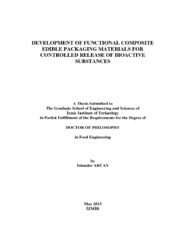Please use this identifier to cite or link to this item:
https://hdl.handle.net/11147/2965Full metadata record
| DC Field | Value | Language |
|---|---|---|
| dc.contributor.advisor | Yemenicioğlu, Ahmet | en |
| dc.contributor.author | Arcan, İskender | - |
| dc.date.accessioned | 2014-07-22T13:48:40Z | - |
| dc.date.available | 2014-07-22T13:48:40Z | - |
| dc.date.issued | 2013 | en |
| dc.identifier.uri | http://hdl.handle.net/11147/2965 | - |
| dc.description | Thesis (Doctoral)--Izmir Institute of Technology, Food Engineering, Izmir, 2013 | en |
| dc.description | Includes bibliographical references (leaves: 113-135) | en |
| dc.description | Text in English; Abstract: Turkish and English | en |
| dc.description | xvii, 144 leaves | en |
| dc.description | Full text release delayed at author's request until 2015.06.19 | en |
| dc.description.abstract | The aim of this study was to control the release of bioactive agents by modification of hydrophobicity and morphology of zein films using composite and blend film making methods. The bioactive agents incorporated into zein based films were lysozyme and phenolic compounds. The incorporation of beeswax, carnauba or candelilla wax into films gave composite films containing amorphous wax particles, while the incorporation of oleic, lauric or linoleic acid into films caused formation of blend films containing many spherical zein capsules within their matrix. The release profiles of phenolic compounds from zein films were successfully altered by the development of composite and blend films. The composites and blends can show 2.5 to 17 fold lower lysozyme release rates than the controls. The lysozyme release rates of composites reduced as the melting point of waxes increased. The chain length and the concentration of fatty acid used in blend films could also have affected the release rates of lysozyme. The phenolic antioxidants, catechin, gallic acid, p-hydroxy benzoic acid and ferulic acid are effective plasticizers of zein films. These phenolic compounds eliminate the classical brittleness problem of zein films and increase their flexibility considerably (up to 196%). Furthermore, catechin contributed to controlled release properties of films by reducing the film porosity. The phenolic compounds also provided antioxidant activity to films (up to 86 μmol Trolox/cm2). The blends and composites of zein films containing phenolic compounds or lysozyme and phenolic compounds showed antimicrobial activity on critical food pathogenic bacteria or indicator microorganisms including Escherchia coli O157:H7, Listeria monocytogenes, Listeria innocua and Campylobacter jejuni. This work showed the possibility of obtaining advanced edible films having flexibility, antimicrobial and antioxidant activity and controlled release properties. | en |
| dc.language.iso | en | en_US |
| dc.publisher | Izmir Institute of Technology | en |
| dc.rights | info:eu-repo/semantics/openAccess | en_US |
| dc.subject.lcsh | Food--Packaging | en |
| dc.subject.lcsh | Food--Packaging--Technological innovations | en |
| dc.subject.lcsh | Edible coatings | en |
| dc.title | Development of functional composite edible packaging materials for controlled release of bioactive substances | en_US |
| dc.type | Doctoral Thesis | en_US |
| dc.institutionauthor | Arcan, İskender | - |
| dc.department | Thesis (Doctoral)--İzmir Institute of Technology, Food Engineering | en_US |
| dc.relation.publicationcategory | Tez | en_US |
| item.fulltext | With Fulltext | - |
| item.grantfulltext | open | - |
| item.languageiso639-1 | en | - |
| item.openairecristype | http://purl.org/coar/resource_type/c_18cf | - |
| item.cerifentitytype | Publications | - |
| item.openairetype | Doctoral Thesis | - |
| Appears in Collections: | Phd Degree / Doktora | |
Files in This Item:
| File | Description | Size | Format | |
|---|---|---|---|---|
| 10003653.pdf | DoctoralThesis | 5.67 MB | Adobe PDF |  View/Open |
CORE Recommender
Page view(s)
134
checked on Nov 18, 2024
Download(s)
108
checked on Nov 18, 2024
Google ScholarTM
Check
Items in GCRIS Repository are protected by copyright, with all rights reserved, unless otherwise indicated.